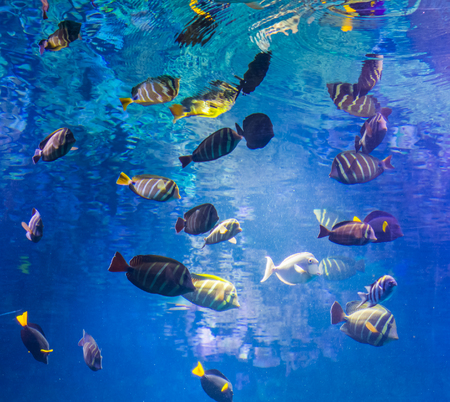Introduction to Fish Quarantine in the UK
Fish quarantine is a crucial practice for anyone involved in aquaculture, ornamental fish keeping, or fisheries within the United Kingdom. The primary aim of these procedures is to prevent the introduction and spread of infectious diseases among local aquatic populations. Given the unique nature of British waterways—from rural lakes and rivers to urban garden ponds—the health of native species and the sustainability of aquatic environments are directly affected by how well quarantine protocols are followed. UK-specific regulations, such as those overseen by the Centre for Environment, Fisheries and Aquaculture Science (Cefas) and compliance with The Import of Live Fish (England and Wales) Act 1980, set stringent requirements for importing, transferring, and introducing new fish stock. These rules are designed not only to protect commercial fisheries but also to safeguard wild populations and delicate habitats from invasive pathogens. Therefore, understanding and implementing effective fish quarantine measures is an essential responsibility for both hobbyists and professionals across the UK.
Legal Requirements and Industry Guidelines
Understanding the legal framework and recommended guidelines is crucial for anyone involved in fishkeeping or the aquatic trade in the UK. The government, through Defra (Department for Environment, Food & Rural Affairs), along with respected industry bodies, sets forth clear standards to ensure biosecurity and prevent the spread of aquatic diseases.
Key UK Laws and Regulations
There are several important laws and regulations that govern fish quarantine procedures in the UK. These include requirements for both hobbyists and commercial enterprises when introducing new fish or moving stock between premises.
| Legislation/Guidance | Main Points | Who It Applies To |
|---|---|---|
| Aquatic Animal Health Regulations 2009 | Mandates health checks, reporting of notifiable diseases, and official approval for some premises | Fish farms, importers, retailers |
| Defra Import Rules | Requires health certification and quarantine for certain imports, especially non-native species | Importers, wholesalers |
| The Animal Welfare Act 2006 | Ensures duty of care to minimise disease transmission and suffering during quarantine | All fish keepers (commercial & hobbyists) |
| Cefas (Centre for Environment, Fisheries & Aquaculture Science) Guidance | Recommends best practices for disease prevention, including isolation protocols | Industry professionals & advanced hobbyists |
Best Practices from UK Fishkeeping Associations
The UKs leading aquatics associations such as the Ornamental Aquatic Trade Association (OATA) and British Koi Keepers Society (BKKS) provide practical guidance tailored to real-world situations:
- Quarantine Duration: A minimum of 21 days is standard for most new arrivals.
- Disease Monitoring: Daily observation and periodic health checks are encouraged during isolation.
- Record Keeping: Documenting source, date of arrival, symptoms observed, treatments administered.
- Biosecurity Measures: Use separate equipment for quarantine tanks; avoid cross-contamination with main displays.
- Reporting Protocols: Immediate notification to authorities (Defra or Cefas) if a notifiable disease is suspected.
Your Responsibilities as a Fish Keeper in the UK
No matter your level of experience, compliance with both legal requirements and industry guidelines is essential. This not only protects your own stock but also supports the wider UK aquatics community by helping to control outbreaks before they spread further.
![]()
3. Setting Up a Quarantine System
Establishing an effective quarantine system is essential for both home aquarists and commercial fishkeepers in the UK to prevent the introduction and spread of disease. Here are some practical steps and considerations tailored to British standards and conditions:
Choosing the Right Quarantine Tank
Begin by selecting a separate aquarium or tank, ideally one that can hold at least 10-20% of your main system’s volume. For UK homes, a 60-litre (15-gallon) tank is often sufficient for small batches of fish, while commercial settings may require larger or multiple tanks. Ensure the tank is made from sturdy glass or acrylic and is easy to clean.
Essential Equipment
Your quarantine setup should include a reliable heater, as stable temperatures are key in the UK’s variable climate. A simple sponge filter is recommended; it offers gentle filtration without creating strong currents that could stress newly arrived fish. Cover the tank with a tight-fitting lid to prevent escapes and reduce contamination risk.
Water Quality and Preparation
Fill the quarantine tank with dechlorinated tap water—British tap water often contains chloramines, so use a suitable conditioner. Match temperature and pH as closely as possible to your main system to minimise shock. Monitor ammonia, nitrite, and nitrate levels daily using accurate test kits.
Location Matters
Place your quarantine tank in a quiet area away from direct sunlight, draughts, and vibration. Avoid locating it near your main display tanks or other aquatic systems to reduce the risk of cross-contamination through airborne droplets or shared equipment.
Ongoing Maintenance Tips
Change 20-30% of the water every few days, particularly during the first fortnight when fish are most vulnerable. Clean filters with tank water rather than tap water to preserve beneficial bacteria. Use dedicated nets, siphons, and cleaning tools exclusively for quarantine tanks; mark them clearly to avoid mix-ups.
Monitoring and Record-Keeping
Keep detailed notes on each batch of fish in quarantine, recording feeding behaviour, health observations, and any treatments administered. This practice is especially important in commercial contexts and supports compliance with UK animal welfare guidelines.
A well-planned quarantine system is your first line of defence against disease outbreaks—investing time now protects your aquatic stock for years to come.
Fish Health Monitoring and Disease Identification
Maintaining the health of quarantined fish is essential to prevent the introduction and spread of disease in UK aquatic environments. Effective monitoring and timely identification of illnesses are key components of robust quarantine procedures. By establishing a regular observation routine and keeping accurate records, fish keepers can quickly detect issues and respond appropriately.
Recognising Common Fish Diseases in the UK
The most prevalent fish diseases in the UK include White Spot (Ich), Fin Rot, Velvet Disease, and fungal infections. Early detection is crucial for effective management and prevention of outbreaks. Below is a summary table highlighting common symptoms to watch for:
| Disease | Key Symptoms | Typical Causes |
|---|---|---|
| White Spot (Ich) | Small white cysts on skin and gills, rapid gill movement, rubbing against objects | Parasite introduction, stress from poor water quality |
| Fin Rot | Torn or ragged fins, discolouration at fin edges, lethargy | Bacterial infection, poor water conditions |
| Velvet Disease | Gold-dust-like coating on body, clamped fins, laboured breathing | Parasitic protozoa, sudden temperature changes |
| Fungal Infections | Cotton wool-like growths on skin or gills, loss of appetite | Injury, previous illness, dirty water |
Routine Observation Techniques
Consistent monitoring should be performed daily throughout the quarantine period. Best practices include:
- Visual Checks: Observe each fish individually for abnormal behaviour such as erratic swimming, isolation, or lack of appetite.
- Physical Assessment: Look for visible signs like lesions, colour changes, or abnormal growths.
- Environmental Review: Ensure water parameters (temperature, pH, ammonia) remain within species-appropriate ranges.
- Behavioural Notes: Record any unusual activity, such as excessive scratching or gasping at the surface.
Record-Keeping for Quarantine Success
Diligent record-keeping not only helps track health trends but also aids veterinary professionals if treatment becomes necessary. Use a simple logbook or digital spreadsheet to document:
- Date and time of observations
- Description of symptoms noted (if any)
- Treatments administered and dosages used
- Water test results and maintenance activities performed
- Status updates at the end of the quarantine period
A Practical Example Entry:
| Date/Time | Observation Details | Treatment/Action Taken |
|---|---|---|
| 12/06/2024 09:00 AM | Saw one goldfish with white spots on tail fin; fish scraping against decor. | Began Ich treatment; increased aeration; monitored closely. |
| 14/06/2024 09:00 AM | No new spots observed; affected fish more active. | Continued Ich treatment as per schedule. |
This structured approach to monitoring and documentation empowers UK fish keepers to act swiftly at the first sign of trouble, thereby greatly reducing the risk of disease spreading beyond the quarantine system.
5. Quarantine Protocols and Step-by-Step Procedures
Introduction to UK Fish Quarantine Standards
When it comes to protecting the health of your aquatic stock, following a clear and consistent quarantine protocol is essential. In the UK, these procedures are designed to align with both local regulations and practical experience in preventing disease spread among ornamental, commercial, and hobbyist fish collections.
Step 1: Setting Up a Dedicated Quarantine Tank
Begin by preparing a separate tank, ideally located in a different room from your main display or holding tanks. The quarantine tank should be fully cycled, equipped with its own filtration system, heater (if necessary), and cover to prevent cross-contamination. Avoid sharing equipment between tanks unless thoroughly disinfected between uses.
Step 2: Initial Observation and Acclimatisation
Upon arrival, carefully acclimatise new fish to the quarantine tanks water conditions using the drip method or similar gradual introduction technique. Observe for any signs of stress or illness over the first 24-48 hours. Its common practice in the UK to keep new fish in quarantine for a minimum period of 14-21 days; however, extending this to 28 days is recommended for high-value or sensitive species.
Step 3: Preventative Treatments
During the quarantine period, many UK aquarists administer broad-spectrum treatments as a precaution. These may include anti-parasitic baths (such as formalin or salt), antibacterial remedies, and gentle anti-fungal solutions—always following product guidelines and considering fish species sensitivity. Its advisable to consult with a local aquatic veterinarian for specific recommendations.
Routine Water Testing and Maintenance
Test water parameters (ammonia, nitrite, nitrate, pH) regularly to ensure optimal conditions are maintained. Perform partial water changes at least twice weekly to dilute waste products and support fish recovery.
Step 4: Ongoing Monitoring and Health Checks
Throughout the observation period, monitor fish behaviour daily for symptoms such as loss of appetite, abnormal swimming, visible spots or lesions, and rapid gill movement. Document any changes and adjust treatment protocols if necessary.
Reintroduction Guidelines
If no signs of disease are present after the full quarantine duration—and all preventative treatments have been completed—the fish can be gradually introduced to their permanent home. Transfer should be done gently, ideally during a quiet time of day to minimise stress.
Summary of Best-Practice Timelines
– Standard quarantine: 14–21 days
– Extended precautionary period: up to 28 days
– Daily health checks and water quality monitoring
– Preventative treatments applied early in quarantine
– No equipment sharing without strict disinfection protocols
Adhering to these structured procedures not only meets best-practice standards across the UK but also significantly reduces the risk of introducing harmful pathogens into established fish communities.
6. Biosecurity Measures and Preventing Cross-Contamination
Maintaining rigorous biosecurity is crucial in UK fishkeeping to prevent the spread of disease between new arrivals and established populations. Adopting these strategies will help safeguard your aquatic environment and uphold the high standards expected within the British aquarist community.
Separate Quarantine Facilities
The first line of defence is to house new fish in a dedicated quarantine tank, physically isolated from your main display aquarium. Avoid using shared nets, siphons, or buckets between tanks. If possible, set up your quarantine area in a different room or at least several metres away to reduce airborne transmission risks.
Strict Cleaning Protocols
All equipment used with quarantined fish should be thoroughly disinfected after each use. A mild bleach solution (prepared according to UK safety guidelines) or a commercially available aquarium disinfectant works well. Always rinse items with dechlorinated water before reintroducing them to any tank.
Hygiene for Fishkeepers
Wash hands thoroughly before and after handling fish or equipment. Consider using disposable gloves, especially when dealing with potentially infected specimens. Keep towels, aprons, or other materials used for quarantine purposes separate from those used for your main tanks.
Water Change Practices
Always perform water changes on your established tanks before attending to the quarantine setup. This minimises the risk of carrying pathogens from new arrivals into existing populations. Dispose of waste water from the quarantine tank responsibly, ensuring it does not come into contact with other fish habitats or local watercourses, in line with UK environmental regulations.
Monitoring and Record-Keeping
Keep detailed records of all new arrivals, noting dates of introduction, observed behaviours, treatments administered, and any signs of illness. This proactive approach allows you to respond swiftly should symptoms arise and helps trace potential sources of infection.
Community Awareness
If you’re part of a local UK fishkeeping club or society, share knowledge about biosecurity best practices and stay informed about regional disease outbreaks. Working together as a community strengthens everyone’s ability to prevent cross-contamination and protect both captive and wild fish stocks.
7. Reporting and Responding to Disease Outbreaks
Immediate Actions When Disease Is Detected
If you suspect or confirm a disease outbreak in your fish stock, it is crucial to act swiftly and responsibly. First, isolate the affected tank or pond to prevent the potential spread of pathogens. Cease movement of fish, water, and equipment between systems until further notice. Observe all biosecurity protocols, including disinfection of tools and footwear.
UK Reporting Systems
The UK maintains strict regulations for reporting notifiable aquatic diseases. If you suspect a notifiable disease (such as Koi Herpesvirus or Infectious Salmon Anaemia), you are legally required to report it immediately to the Centre for Environment, Fisheries and Aquaculture Science (Cefas) Fish Health Inspectorate. Reports can be made by telephone or online through the official GOV.UK portal. Early reporting protects both your own stock and the wider aquatic community.
What Information Should You Provide?
Be prepared to give details such as: species affected, number of fish showing symptoms, description of clinical signs, recent movements of fish or equipment, water source information, and photographs if possible. Accurate information supports swift investigation and containment.
Accessing Support Services
Cefas Fish Health Inspectorate will guide you on next steps, which may include on-site inspection, sample collection for laboratory diagnosis, and advice on containment. Do not attempt to treat or dispose of affected fish without official guidance, as incorrect action could worsen the situation or breach legal obligations.
Community Resources and Guidance
The UK aquatics community is well-supported through organisations such as the Ornamental Aquatic Trade Association (OATA), British Trout Association (BTA), and local angling clubs. These bodies offer advice lines, forums for experience sharing, and updates on best practice. Joining these networks ensures you stay informed about emerging threats and effective prevention strategies.
Summary of Best Practice
Prompt reporting and following official procedures are not only legal requirements but also vital steps in protecting fish health across the UK. By working closely with authorities and industry groups, you contribute to a safer environment for aquatic life—and peace of mind for everyone involved in fish keeping and aquaculture.


